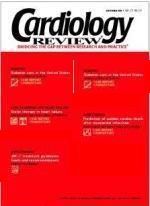Publication
Article
Cardiology Review® Online
Should postoperative troponin elevation change patient management?
Despite several articles that enumerate the factors causing false positive elevations in troponin levels,1,2 this biochemical marker has been proven to be a reliable and sensitive indicator of myocardial damage.3,4 Utilizing this datum, the study by Landesberg and colleagues (page 33) confirms several of what should be intuitively obvious presumptions: first, that patients undergoing major vascular surgery have an increased incidence of coronary artery disease, and second, that exacerbation of this disease results in increased postoperative mortality.
The authors studied 447 patients who underwent major vascular surgery (231 carotid endarterectomies, 77 aortic aneurysm repairs, and 192 lower extremity bypasses). Unfortunately, they did not stratify their patient population further based
on the type of surgery performed. There is certainly a difference in cardiac risk in the three classes of surgical procedures cited. Carotid endarterectomies and infrainguinal bypasses create far fewer physiologic myocardial stresses than aortic procedures. Cross-clamping of the aorta creates a sudden increase in afterload resistance and may also have deleterious effects on renal function. After aortic revascularization is accomplished, the “unclamping” phenomenon also has several negative effects on the myocardium, including reperfusion into a dilat-
ed lower extremity vascular bed (with resultant hypotension), sudden flushing of acidotic metabolites into the circulation from the previously ischemic limbs, and acute decreases in afterload resistance. All of these occurrences clearly contribute to the observed myocardial damage. It would be interesting to see whether this subset of patients is the most likely to develop untoward cardiac events. As the shift toward endovascular aortic aneurysm repair (as opposed to open repair) gains momentum, one would expect to see a significant reduction in cardiac risk in aortic surgery. In fact, recent publications have reported a reduction of cardiac complications in endovascular aortic surgery to nearly zero.5
The real question the study by Landesberg and colleagues posits is whether or not this observation is clinically important. In other words, should the discovery of postoperative cardiac marker enzyme elevations change the management of these patients? If so, can it be done in a cost-effective manner?
Conclusion
In my own practice (an academic-affiliated community practice), patients such as these would be discharged after the usual hospital stay with continued outpatient surveillance by their cardiologist. Further cardiologic evaluation is then done electively as needed. In the absence of additional evidence of myocardial infarction (diagnostic electrocardiogram changes or clinical symptoms), there appears to be no need for acute cardiac intervention, lengthened hospitalization, or change in therapy.
